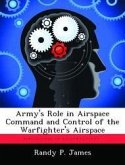In 1965 the Joint Chiefs of Staff tasked the Air Force to develop a joint airspace control doctrine. The Services could not agree on the contents of the draft manuals prepared by the Air Force. This study analyzed the issues which prevented service agreement, reviewed the recommendations of other researchers, and then proposed and tested a conceptual solution to the inter-service problem. A concept of nine airspace control modes was presented to select officers from the U.S. Army Command and General Staff College and the Combined Arms Combat Developments Activity (CACDA). The nine modes as presented were not determined to be acceptable for joint doctrine; however 35 of the 48 officers who participated in the test indicated that three or more modes of operation should be used for joint airspace control.
Hinweis: Dieser Artikel kann nur an eine deutsche Lieferadresse ausgeliefert werden.
Hinweis: Dieser Artikel kann nur an eine deutsche Lieferadresse ausgeliefert werden.








